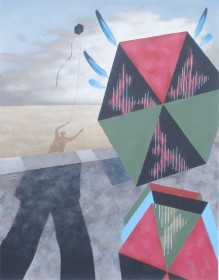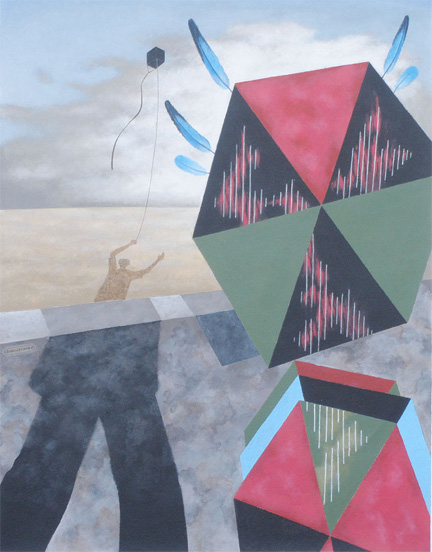
The work is arresting because it provokes a number of questions: Why are there feathers on the kite? How come a shadow is flying a kite? How come the kite is rising without a string or a tail? Why are there differences between the ‘real’ kites and the shadow kite? and perhaps more importantly – Where is the person who casts the shadow of the kite-flyer in the painting?
It is a truism that on encountering something new the primary reaction is an attempt to make sense of what one is encountering – in the case of visual arts, what one is seeing. The pragmatic or realist approach arises from this impulse to relate what is seen to the logical or the real.
Where a work is less representational, however, other methods may be employed in the search for meaning, and a number of these approaches or processes of analysis exist.
The symbolism of the objects – the kite, the shadow, the feathers, etc – in the painting may be considered. Its visual language might be analysed. Its iconography may be decoded. In a technical approach to the work, the use of colour and its symbolic effect might also be considered. Texture in the painting, eg, that in the depiction of the sea wall, the striations in the kite panels, etc, or other technical aspects might be looked at in terms of the meaning conveyed.
One might also examine the structural relationships in the painting, for example its dualities: air/water; sea-wall/ocean, substance/ ethereal, aloft/ aground, light/shadow etc, and what their presence signifies, thereby arriving at conclusions about the work.
Yet again, one might seek meaning using the artist’s life as a frame of reference, in what might be called a biographical analysis, based on the view that the artist is communicating something of a personal response to the world through his work. In this context the objects in the painting are referenced to the artist’s personal interests and life. Using this method, Greaves’s Jesuit education, his interests in Egyptology and metaphysical themes, his childhood in a tenement yard and his nationality become relevant. That the piece was produced outside of Guyana is interesting in this case, because it raises other tangentially related questions, eg, whether an artist’s distance from his/her homeland affects the nature of the work produced and if so, how. These questions typically interest cultural anthropologists, having their basis in the argument that art is in one sense a cultural product, in effect an artefact, and consequently bears a relationship to its location.
Another approach might be to look at the painting from a Christian theological perspective. The title of the painting. ‘Easter Kite’ is very relevant in this context, and the painting might be interpreted in these terms as a ‘twist’ on the idea of the rising kite as a symbol of the risen Christ, an idea that was believed to have been promulgated by the Chinese who are considered to have introduced kite-flying to Guyana in the 19th century. Seen in this light the kites symbolise human beings who are elevated through their connection to God. Other concerns of the painting in this case might be the nature of one’s relationship with God, the paradox, in Christian life, of Christ’s simultaneous presence and absence, and the importance of faith.
Given Greaves’s preoccupations, viewing the painting from a metaphysical angle may offer greater insight into the work. In these terms, the feathers possibly bear reference to the ancient Egyptian goddess Maat who, it was believed, judged each person after death by weighing his/her heart (in which the person’s soul was considered to reside) against a feather. The rising kite casts a part shadow that can be seen on the wall behind it, while the kites on the ground do not, possibly indicating the transition from life to death. In this interpretation the rising kite might symbolise a dying soul. The painting as a whole could be seen as a statement about souls waiting to enter the land of shadows, or “mortality put to question” to quote Martin Carter in his poem ‘Demerara Nigger.’ In a slightly different interpretation the shadow kite-flyer might be an ancestor, a now silent kite-flyer in amongst the living. This interpretation may be relevant given that the painting is one of a current series by Greaves called the ‘Shadow Paintings,’ alluding to Edgar Mittelholzer’s novel, Shadows Move Among Them.
Then one may consider those objects which are implied in the work, the unseen among the seen as it were, the visual equivalent of the first line of Martin Carter’s ‘Proem,’ “Not in the saying of you are you said.” One “thing which is seen but unseen” in the painting is the wind, without which the kite would not be aloft. An equivalence might be made here between the wind and fate, and one might ask what comment Greaves is making about fate through this [non]portrayal of the wind.
The main question though is: Where is the kiteflyer? or in other words, where is the human [agent]? By extension one may also ask: What does the absence of the person casting the shadow signify?
The answers possibly lie in perspective. The direction of the wind, inferred from the positioning of the kites, seems to indicate that the viewer of the painting is the missing agent, the person flying the kite. In looking at the kite in the painting the viewer becomes the kite-flyer and his/her line of vision becomes the invisible string by which the kite is held. Expanding this idea along reflexive lines, the viewer’s personal interaction with, or reaction to, the painting becomes the act of flying the kite per se. The feathers may symbolise the imagination.
The variety of analyses resulting from these different approaches to the work can be compared, and it may be the case that thematic commonalities arising from this comparative analysis truly indicate the artist’s intention or message. To my mind Greaves seems to be commenting on the human desire for ascent, spiritually or otherwise, and on the uniqueness of each human experience. He also conveys something of the challenges presented to a visual artist in depicting these concepts, given their universality. Nonetheless the questions posed by the work persist. The answers, like its kite-flyer, remain elusive.






